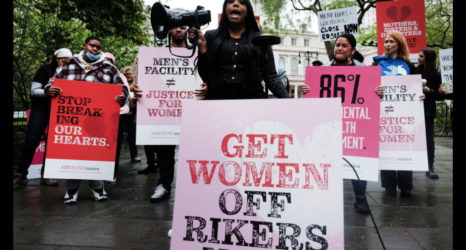For a domestic violence victim, whether her partner owns a gun can be the difference between life and death.
One in four women in the United States experiences domestic violence in her lifetime, and these women are five times more likely to be murdered when their intimate partners own a firearm. Putting a gun in the hands of an abuser is not only irresponsible; it literally risks the lives of countless women across the nation.
Given the dual epidemics of gun violence and violence against women in this country, we should be working to strengthen laws that prevent convicted criminals from accessing deadly firearms. Yesterday, however, the U.S. Supreme Court heard arguments in United States v. Castleman, a case that could limit the effectiveness of the federal gun ban and place victims at further risk.
In 1996, Congress passed the Domestic Violence Offender Gun Ban—also known as the Lautenberg Amendment after its chief sponsor and advocate, the late Sen. Frank Lautenberg (D-N.J.)—to prohibt any individual convicted of a misdemeanor crime of domestic violence from owning a gun. A host of women’s rights groups, including the Feminist Majority, the National Network to End Domestic Violence (then led by current Rep. Donna Edwards [D-Md.]), and the National Organization for Women, fought hard for the law, originally facing opposition from law enforcement and military groups who feared the ban would force out officers.
The purpose of the law, however, was, as Sen. Lautenberg reminded his colleagues on the Senate floor, to “save the life of the ordinary American woman.”
The Senator was not engaging in hyperbole. Several studies have shown that gun ownership increases the likelihood that a woman will be killed during a domestic violence incident, and the risk of death is higher when there has already been a previous incident of violence. The Domestic Violence Offender Gun Ban is a simple, common-sense measure that helps protect women from being murdered.
At issue in Castleman, however, is when the gun ban should apply to those who perpetrate domestic violence. The federal law specifies that the gun ban applies to anyone who has been convicted of a misdemeanor crime of domestic violence under federal, state or tribal law when the crime includes “the use or attempted use of physical force, or the threatened use of a deadly weapon.” The question before the Court now is what counts as “physical force.”
In 2001, James Castleman pled guilty in Tennessee state court to “intentionally or knowingly caus[ing] bodily injury” to the mother of his child, a misdemeanor domestic assault. When Castleman was later arrested for selling firearms on the black market, he argued that he could not be charged with violating the gun ban because he had not specifically pled guilty to use of physical force. Amazingly, the lower courts agreed.
But this case isn’t just about James Castleman. If the Supreme Court upholds the lower courts’ interpretation of the gun ban, it will immensely cripple the law and the protection it affords.
Here’s why:
The term “domestic violence” includes many offensive acts intended to exert power and control over the victim. These acts usually form a pattern of abusive behavior that escalates in frequency and severity over time. We know that what starts out as pushing, grabbing, spitting, or shoving will too often turn into more aggressive violence and that access to guns increases the likelihood of fatality. Most cases are prosecuted under state misdemeanor assault and battery laws, and depending on the state these laws criminalize intentional offensive touching, intentional causation of bodily injury or both.
But if the Supreme Court sides with Castleman, none of the abusers convicted under these laws—representing the majority of domestic violence cases—would be subject to the gun ban if their convictions did not specifically mention “physical force.” This result would be at odds with the intent of the law, and certainly at odds with the reality of domestic violence and its prosecution.
There is no reason to wait for an abuser to exhibit “strong and violent force,” as the lower courts would have us do, before we prevent that abuser from owning a firearm. The risk is too great. When it comes to protecting domestic violence victims, the Court needn’t create or uphold barriers that do not appear in the federal statute banning abusers from owning guns.
“In a country where three women are already murdered every day through domestic violence, it would be tragic beyond measure to re-arm thousands of abusers,” says Kim Gandy, NNEDV president and CEO of the National Network to End Domestic Violence.
The combination of guns and domestic violence is often fatal. More than 60 percent of women homicide victims are killed by an intimate partner, and more homicides of women are committed with firearms than with any other type of weapon. Now is certainly not the time to undermine laws that help save women’s lives.
Read More:





